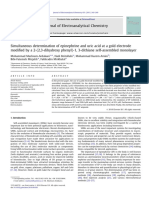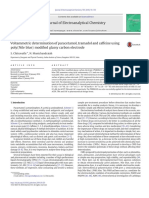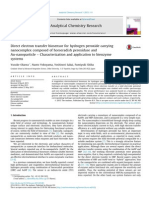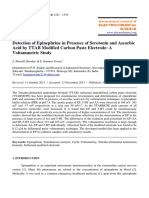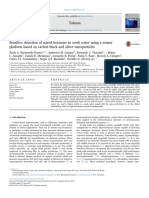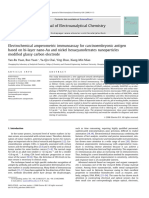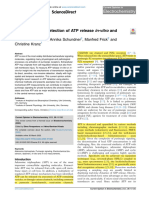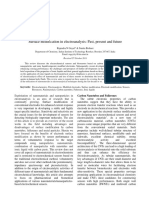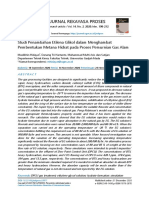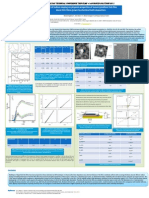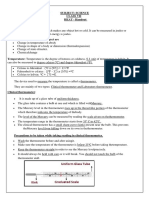Contents lists available at ScienceDirect
Journal of Electroanalytical Chemistry
journal homepage: www.elsevier.com/locate/jelechem
Electrochemical sensor for simultaneous determination of epinephrine andnorepinephrine based on cetyltrimethylammonium bromide assisted SnO
2
nanoparticles
N. Lavanya, C. Sekar
Department of Bioelectronics and Biosensors, Alagappa University, Karaikudi 630003, Tamilnadu, India
A R T I C L E I N F O
Keywords:
Electrochemical sensorNeurotransmittersEpinephrineNorepinephrineSurfactantSnO
2
nanoparticles
A B S T R A C T
A highly sensitive and selective electrochemical sensor has been developed for simultaneous determination of catecholamine neurotransmitters, epinephrine (EP) and norepinephrine (NEP) using cetyltrimethylammoniumbromide (CTAB) assisted SnO
2
nanoparticles (NPs) synthesized by microwave irradiation method. The productswere characterized by powder XRD, HRTEM, UV-visible absorption and FTIR spectroscopy and cyclic voltam-metric methods. The CTAB-SnO
2
NPs modi
ed glassy carbon electrode (GCE) exhibited two sharp well de
nedreduction peaks for EP and NEP with a signi
cant potential di
ff
erence of 0.354 V in phosphate bu
ff
er solution(pH 5.0). Under optimum conditions, the calibration curves for EP and NEP were obtained over a wide con-centration range of 0.1
–
250 and 0.1
–
300
μ
M with the lowest detection limits of 10 and 6 nM for EP and NEPrespectively. Interference studies showed that the modi
ed electrodes have excellent selectivity towards EP andNEP in the presence of potential biological interferents uric acid and ascorbic acid. The proposed electrode hasbeen successfully applied to the simultaneous determination of EP and NEP in human urine samples with sa-tisfactory recoveries.
1. Introduction
Neurotransmitters control the physiological and behavioural con-ditions in human beings by regulating communication within the neuralnetwork. These molecules are involved in a large variety of neuro-physiological processes including learning, sleep, memory and appetite.Damage in secretion or uptake of neurotransmitters is known to causeneurodegenerative diseases, drug addiction, and depressive syndromes[1]. Among various neurotransmitters, two important catecholaminesepinephrine (EP) and norepinephrine (NEP) play essential roles in themammalian central nervous system (CNS). Excess of EP in the bodya
ff
ects the regulation of blood pressure and heart rate, lipolysis, im-mune system and glycogen metabolism. On the other hand, de
ciencyof EP leads to Parkinson's disease. The EP also serves as a chemicalmediator for conveying the nerve pulse to di
ff
erent organs. When EP issecreted into the bloodstream, it rapidly prepares the body for action inan emergency. Hence the EP is used as a common healthcare medicinefor emergency treatment in severe allergic reaction, cardiac arrest andsepsis [2,3].NEP is also a signi
cant transmitter which regulates blood pressure,emotional arousal, and mood disorders. It promotes the conversion of glycogen to glucose in the liver and helps in converting the fats intofatty acids, resulting in an increment in energy production. The NEP isresponsible for the increased heart rate, dilation of pupils, dilation of airpassages in lungs and narrowing of blood vessels due to which body isable to perform well in stressful situations [4]. Knowledge of the con-centrations of plasma catecholamine and their metabolites is oftenuseful for diagnosis and evaluation of therapeutic and pharmacody-namic e
ff
ects for neurological, psychiatric and cardiovascular disorders.Considerable e
ff
orts have been made to develop reliable methods forthe detection of EP and NEP which are structurally similar and oftencoexist in biological samples. The identi
cation and simultaneous de-termination of these neurotransmitters using the electrooxidation pro-cess become di
ffi
cult due to their interference with each other duringidenti
cation. Therefore, the development of an e
ffi
cient electro-chemical sensor to monitor and determine catecholamines in realsamples is very important for non-invasive disease diagnosis andpharmaceutical applications.Various analytical methods including liquid chromatography [5],chemiluminescence [6] and electrophoresis [7] have been employed for
the determination of catecholamines. These conventional methods aretime consuming, expensive and involve tedious procedures for sample
http://dx.doi.org/10.1016/j.jelechem.2017.08.018Received 11 May 2017; Received in revised form 7 August 2017; Accepted 8 August 2017
⁎
Corresponding author.
E-mail address:
Sekar2025@alagappauniversity.ac.in (C. Sekar).
Journal of Electroanalytical Chemistry 801 (2017) 503–510Available online 09 August 20171572-6657/ © 2017 Elsevier B.V. All rights reserved.













